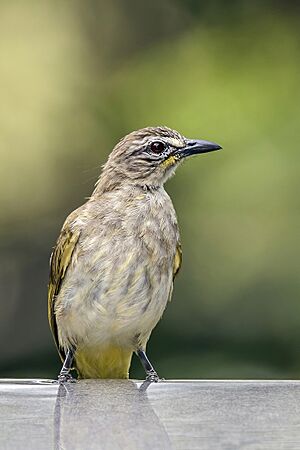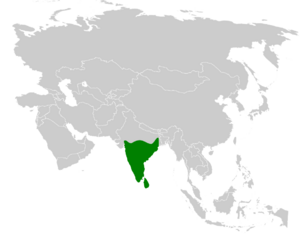White-browed bulbul facts for kids
Quick facts for kids White-browed bulbul |
|
|---|---|
 |
|
| P. l. luteolus Maharashtra, India |
|
 |
|
| P. l. insulae, Sri Lanka | |
| Conservation status | |
| Scientific classification | |
 |
|
| Synonyms | |
|
The white-browed bulbul (Pycnonotus luteolus) is a small bird from the bulbul family. It lives in Sri Lanka and parts of India. This bird is mostly olive-green on its back and white underneath. It has a light stripe above its eye and a yellow patch under its tail. White-browed bulbuls like to hide in thick bushes. They can be hard to spot, but their loud, clear calls make them easy to hear!
Contents
About the White-browed Bulbul
Different Types of White-browed Bulbuls
Scientists recognize two main types, or subspecies, of the white-browed bulbul:
- P. l. luteolus - This type was first described by Lesson in 1841. You can find it in central and southern India.
- P. l. insulae - This type was described by Whistler and Kinnear in 1932. It lives in Sri Lanka.
What Does It Look Like?
The white-browed bulbul is about 20 centimeters (8 inches) long. It has a tail that is about 8 centimeters (3 inches) long. Its upper body is olive-grey, and its belly is whitish.
You can easily spot this bird by a few key features:
- A white stripe above its eye (called a supercilium).
- A white crescent shape just below its eye.
- A dark stripe through its eye.
- A dark stripe near its beak, like a small mustache.
- A yellowish patch under its tail.
- Some yellow on its chin and mustache area.
Its throat is mostly white. This is different from the yellow-throated bulbul, which looks similar but has a yellow throat and lives in rocky areas. Both male and female white-browed bulbuls look alike.
This bird is often heard before it is seen. It sings a rich, bubbly song from the top of a bush. When you get close, it often dives into the bush, making it hard to spot. The P. l. insulae type found in Sri Lanka is a bit darker and has shorter wings than the Indian type.
Where Do They Live?
This bird lives only in southern India and Sri Lanka. In India, you can find them as far north as Gujarat, Madhya Pradesh, and western West Bengal. They prefer dry, open areas with lots of bushes. You might also see them in gardens and forests that have thick shrubs.
Life and Behavior
White-browed bulbuls usually live alone or in pairs. They search for food inside bushes. Their diet includes fruits, nectar from flowers, and insects.
Reproduction and Life Cycle
The breeding season for these birds lasts from March to September. They might even have two sets of babies in one year! The busiest breeding times are in February and again in September. They tend to avoid breeding during the dry months of May to July in some areas.
They build a loose, cup-shaped nest. It is made from small twigs, spiderwebs, and hair. The nest is usually placed low down in a thick bush, often on the edge of it. A female white-browed bulbul typically lays two eggs at a time. These birds can live for more than 11 years!
Images for kids



